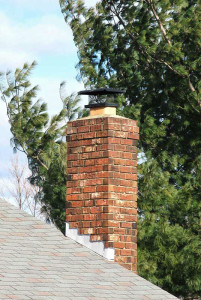Few things can cause as much chimney damage in a short amount of time as a leaky chimney. Because there are a number of chimney components complex that can let water in, diagnosing the source of the leaky chimney can be difficult. However, identifying and repairing the cause of the leaky chimney as soon as possible can minimize damage to the chimney and fireplace system.
Causes of leaky chimneys
There are a number of ways that water can get into your chimney. The following are four of the most common causes of chimney leaks.
- Chimney cap: The chimney cap is a metal top with mesh or wire sides that covers and protects the top of the flue. If the chimney cap is damaged – or missing entirely – water can easily drain directly down the flue and into the fireplace. Chimney caps can also create minor leaks if they do not fit the flue or are installed incorrectly.
- Chimney crown: The chimney crown is the stone or masonry slab that seals the top of the chimney structure around the flue. If chimney crowns are flat, pooling or standing water can slowly cause cracks in and erode the masonry, letting water slowly leak into the chimney. Chimney crowns that are built using the wrong kind of masonry are at particular risk for cracking and water damage.
- Flashing: Flashing is the watertight seal that protects the joint between your chimney and the roofline. There are a number of ways flashing can lose its watertight seal including exposure to the elements, damage, or improper installation. Because of its location, flashing leaks are often misidentified as being caused by the roof; likewise, leaks caused by faulty flashing are more likely to damage building materials like wood, ceilings, and walls.
- Masonry: While the bricks and mortar of your chimney are built to withstand the elements, water can cause serious masonry damage or affect the structural stability of your chimney. During the freeze-thaw process, water absorbed by the masonry expands as it freezes; this leaves behind progressively bigger and bigger holes that can eventually cause the masonry to crack and spall.
Preventing leaky chimneys
The best way to prevent a leaky chimney is through regular chimney maintenance. Annual sweepings and inspections can help spot chimney damage before a chimney leak occurs, fixing the problem before it causes major damage. Chimney inspections are also a vital tool in diagnosing the root cause of chimney leaks.
Likewise, waterproofing can protect your masonry against future damage. The ChimneySaver water repellants create a semi-permeable barrier over the bricks and mortar, keeping water out while still allowing the masonry to release gasses.
Don’t assume a chimney leak will resolve itself on its own; instead, call a chimney professional as soon as possible to have the cause of your chimney leak diagnosed. If you have a leaky chimney, contact Mason’s Chimney Service today for more information on diagnosing and repairing leaky chimneys.

